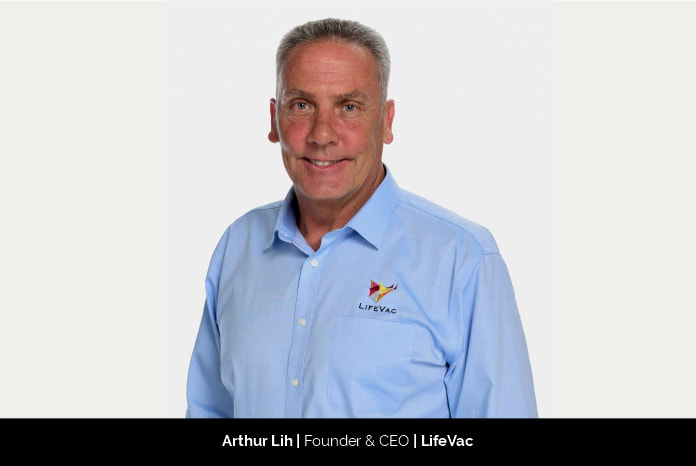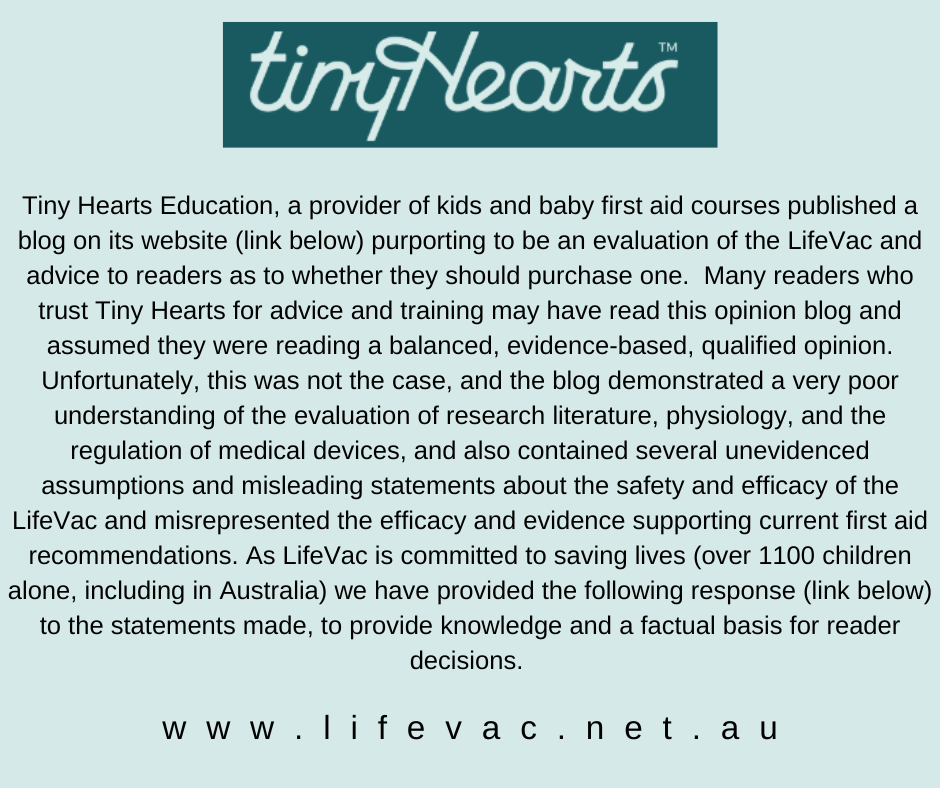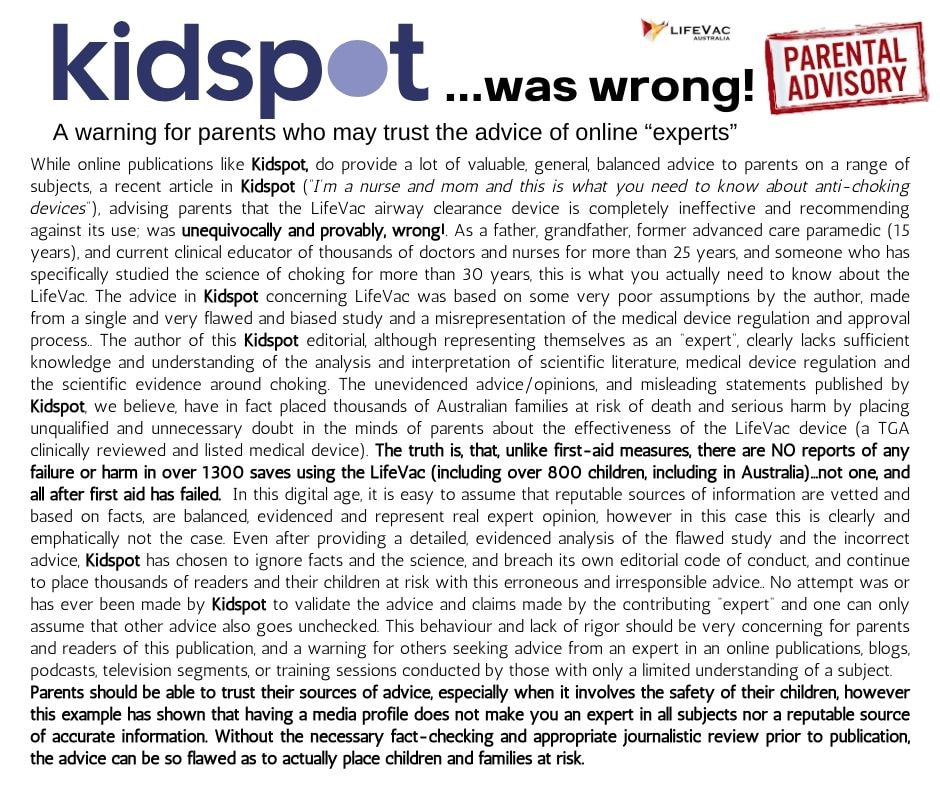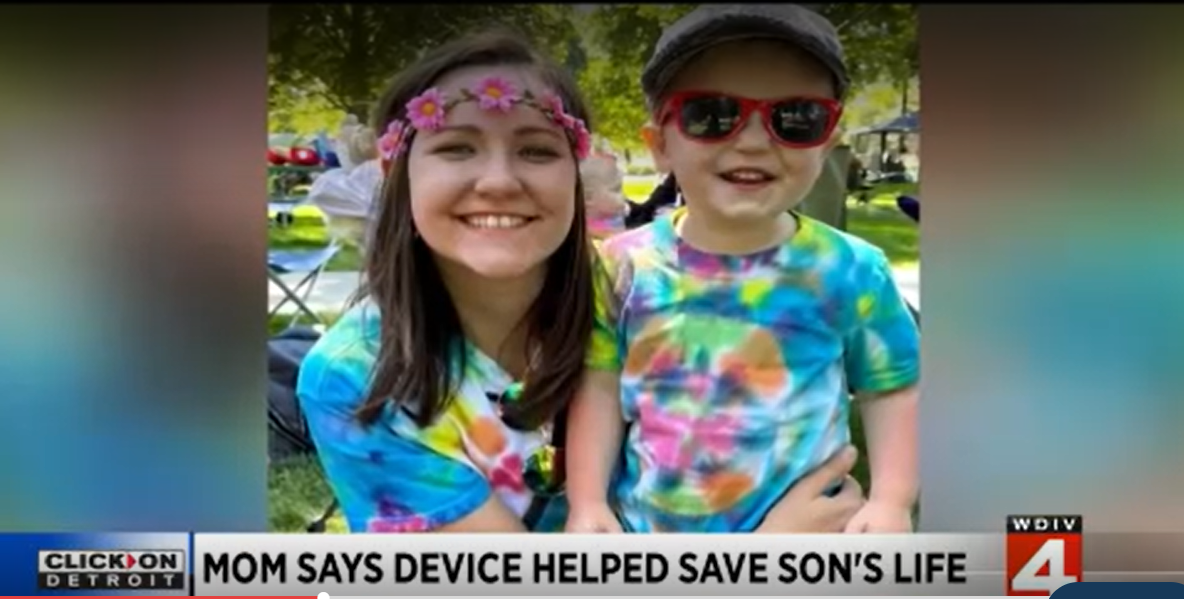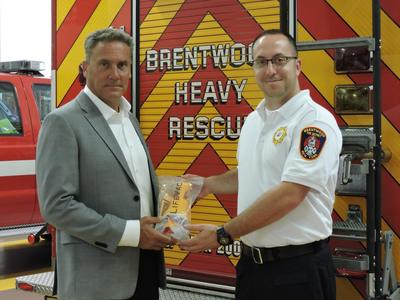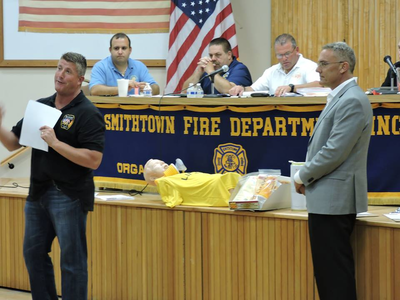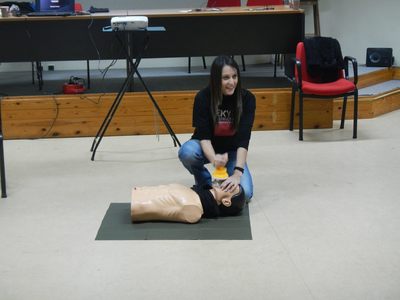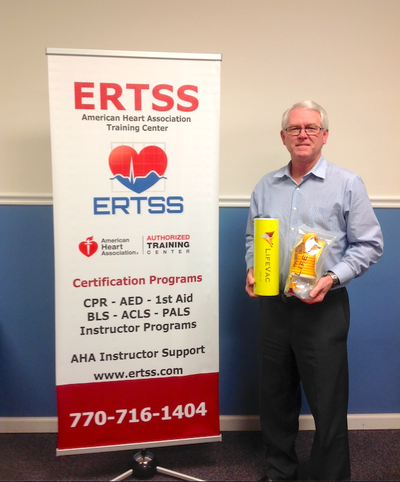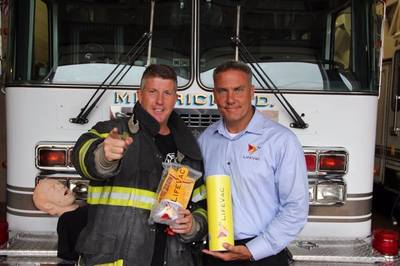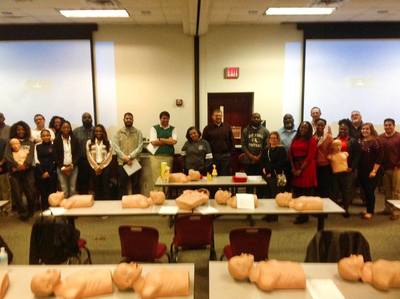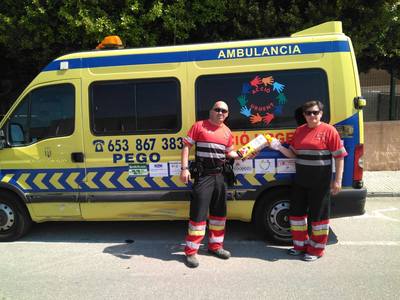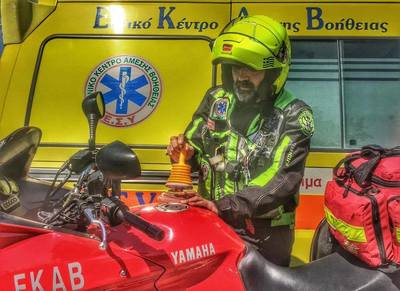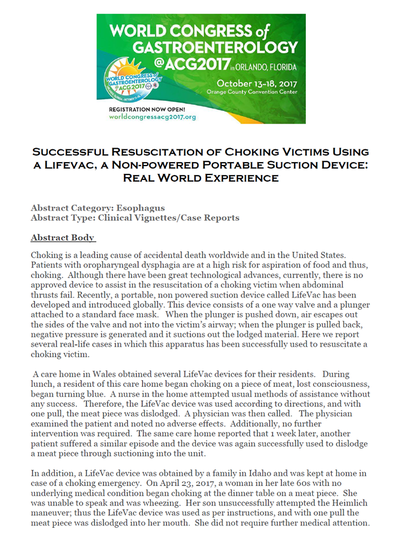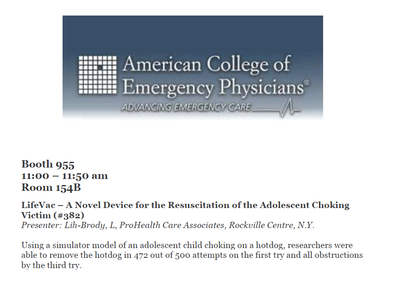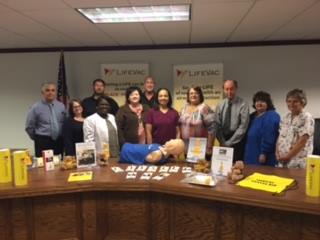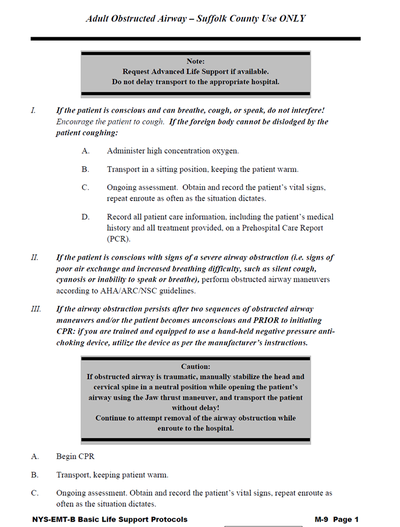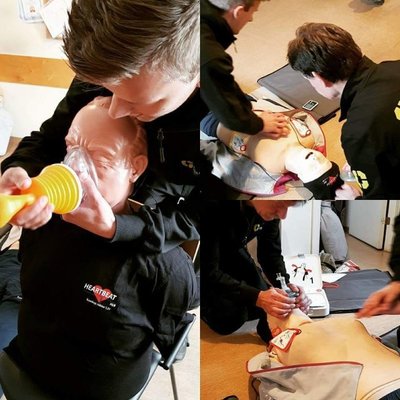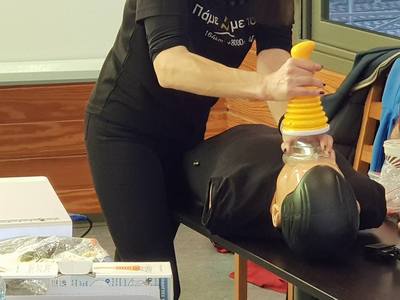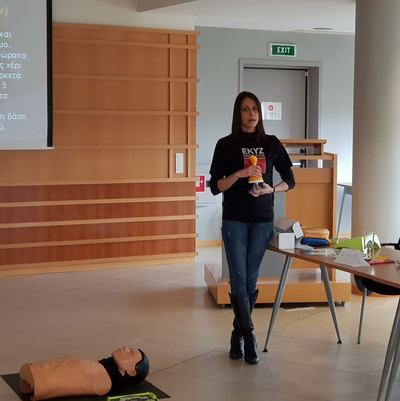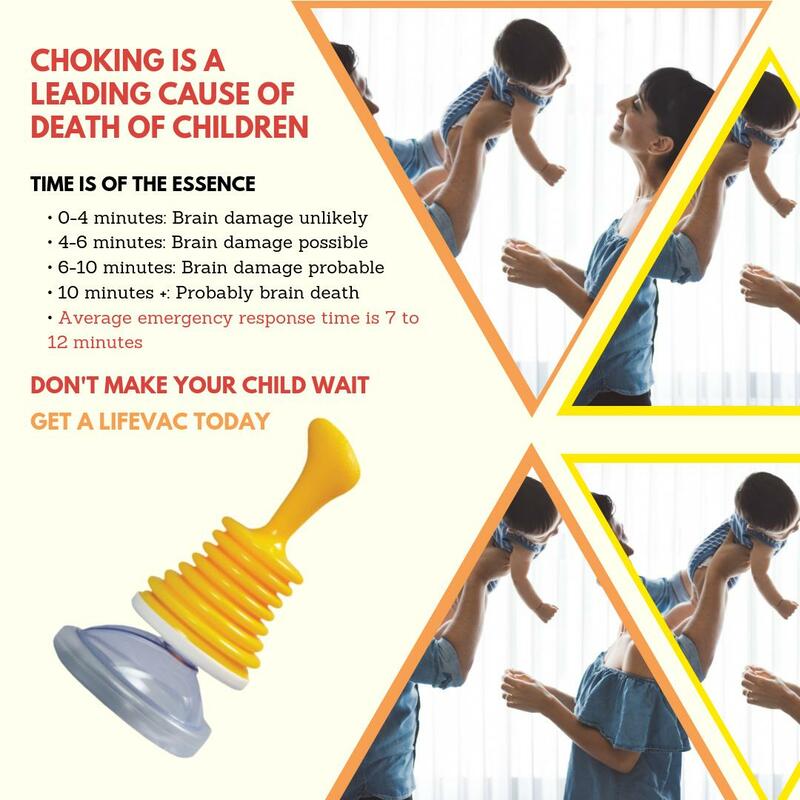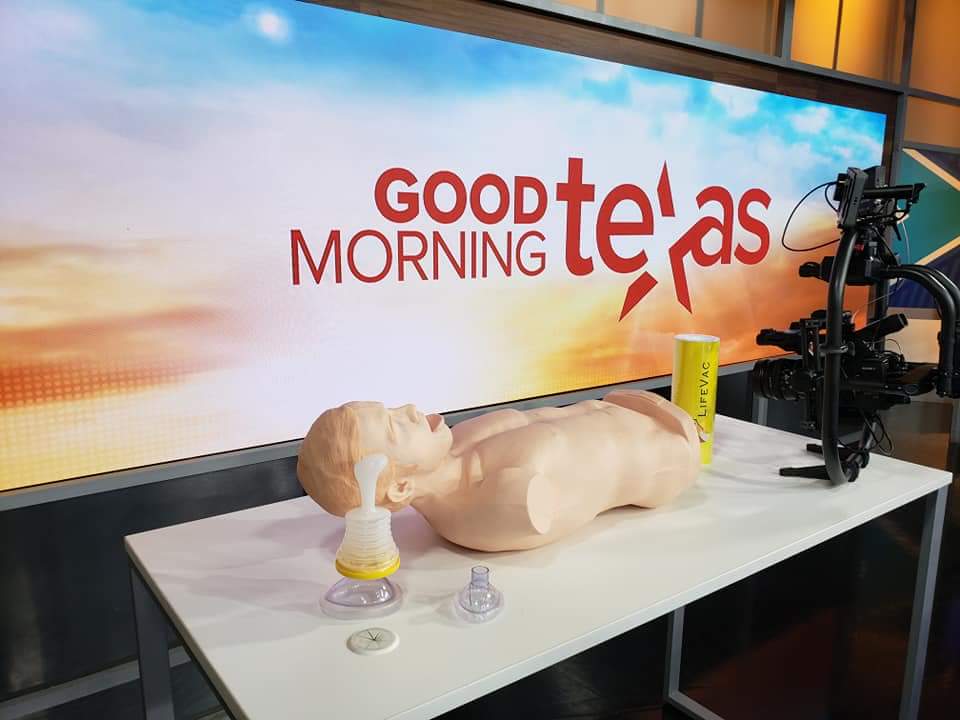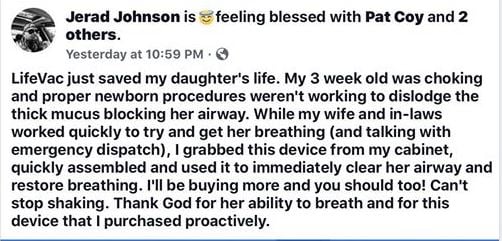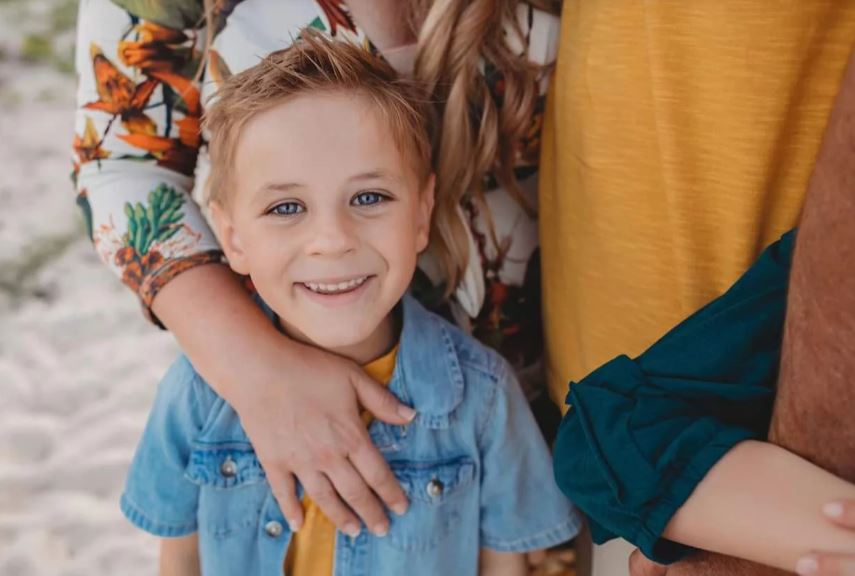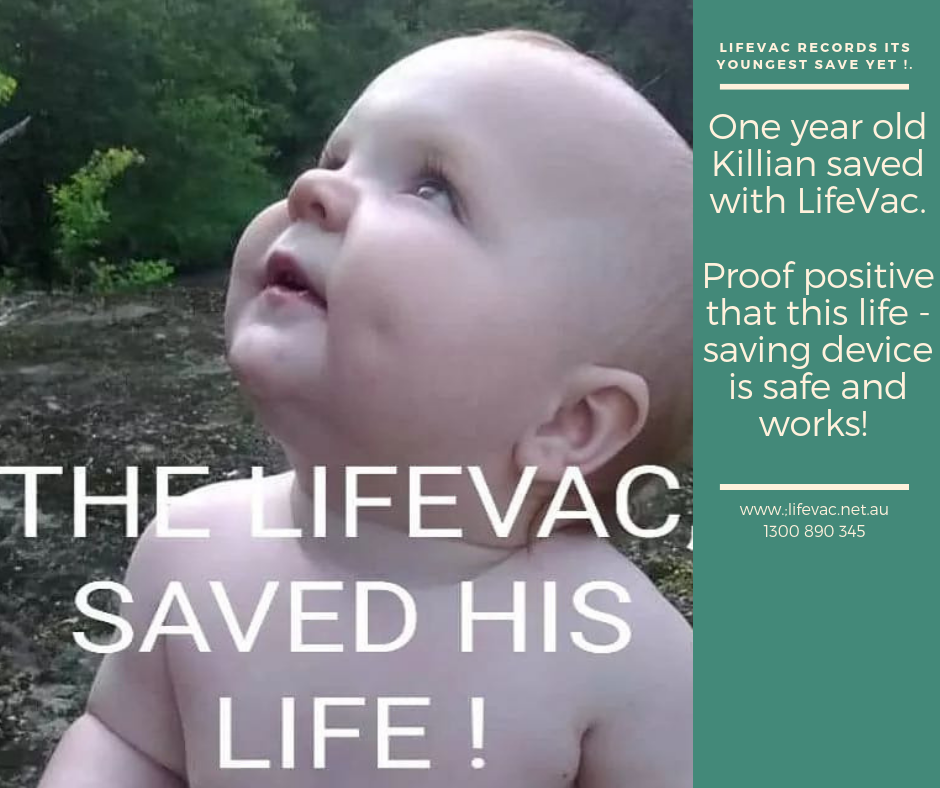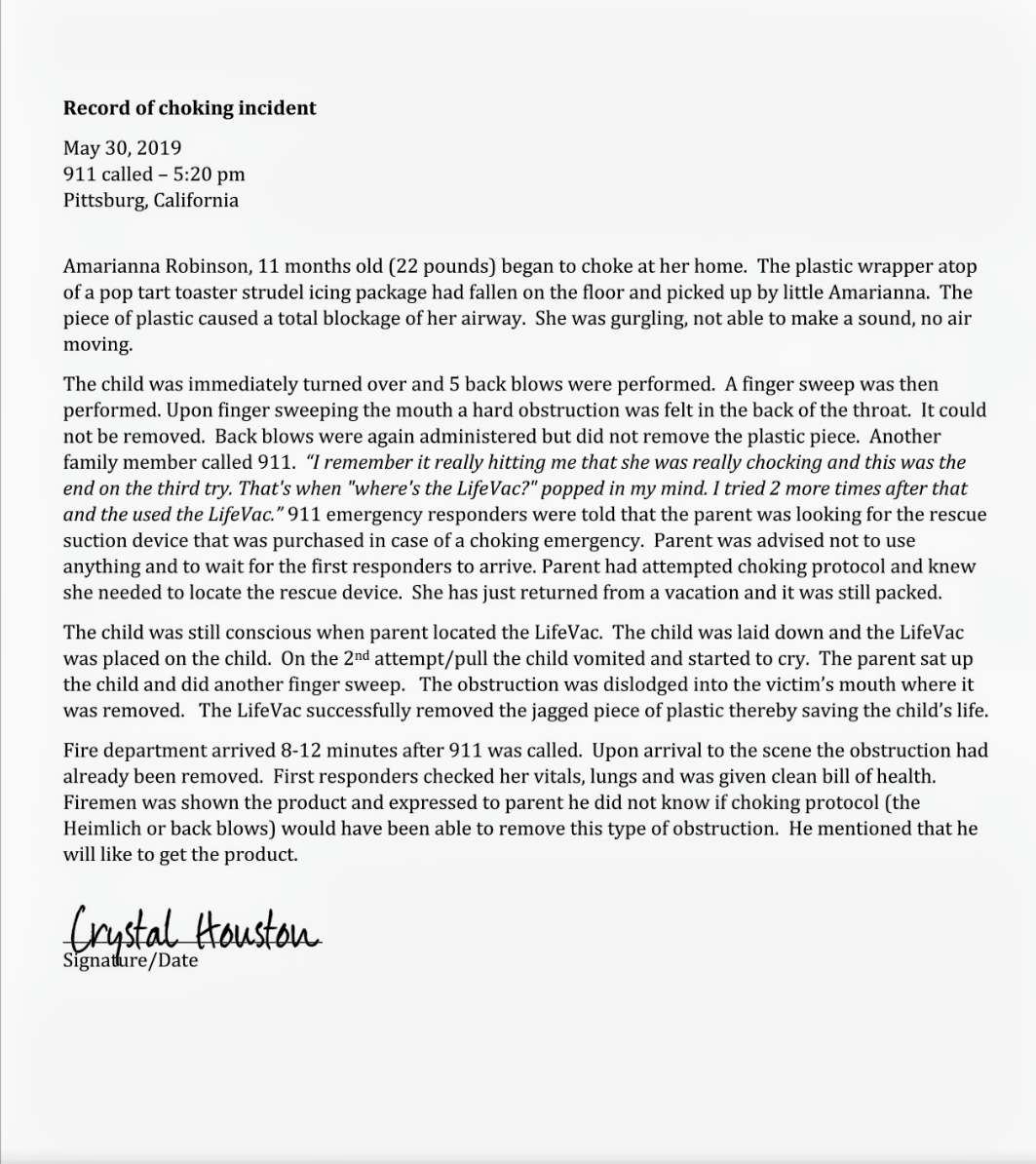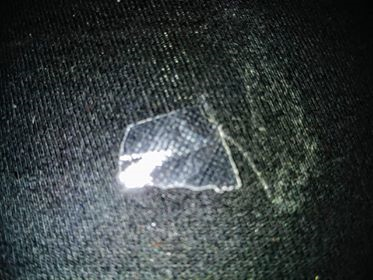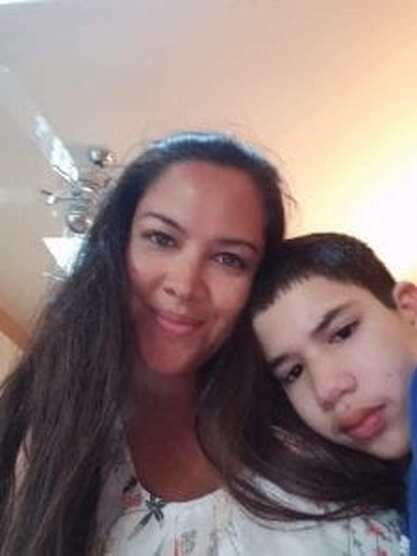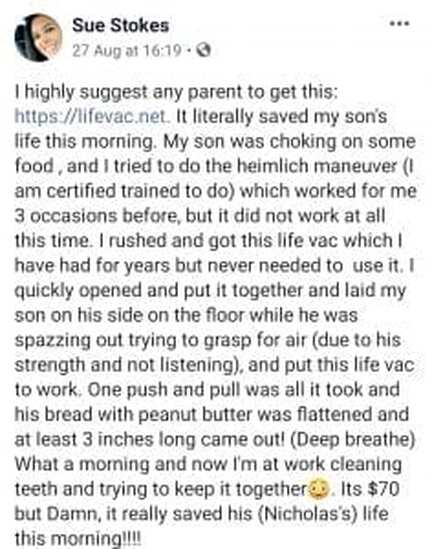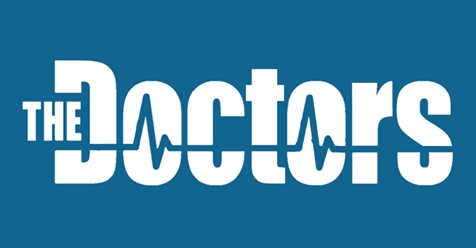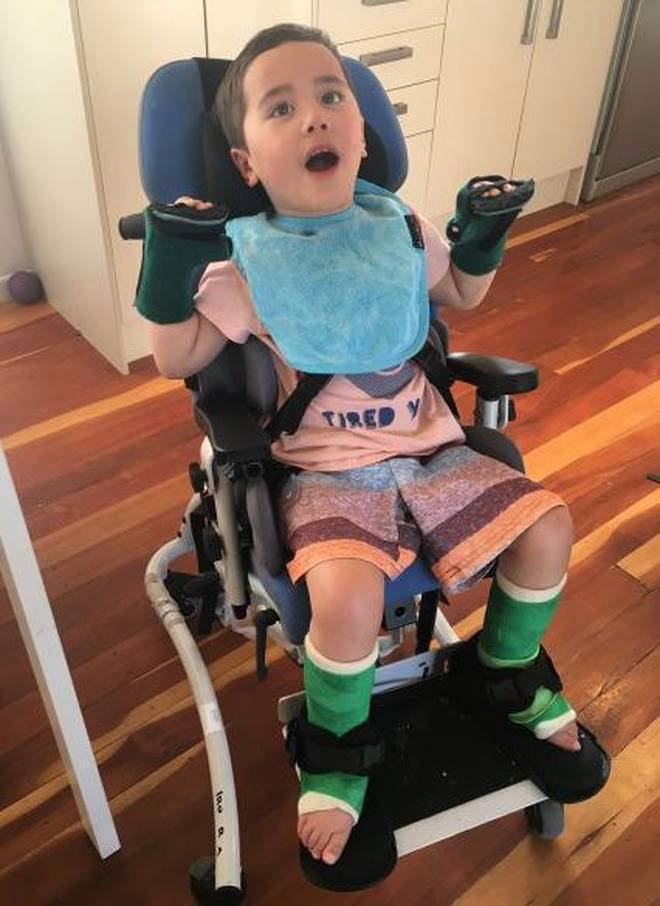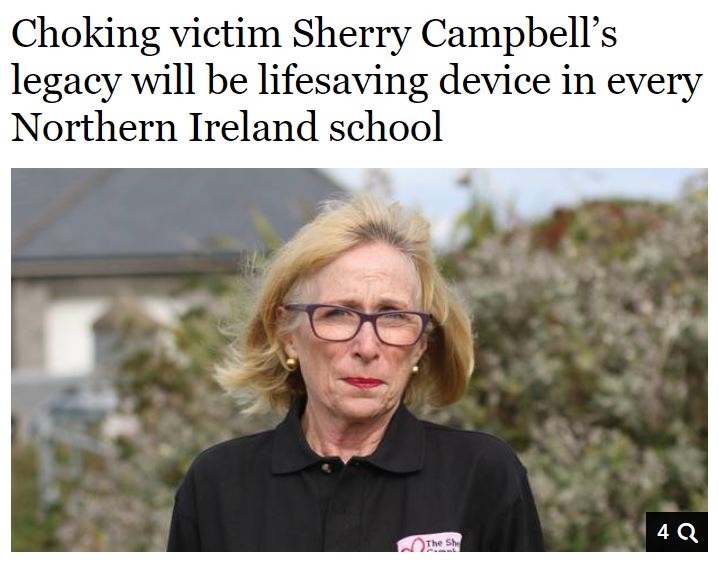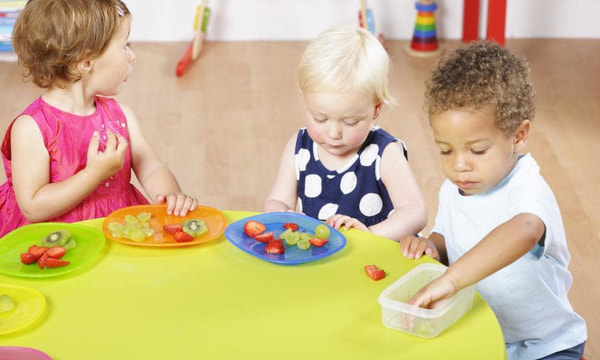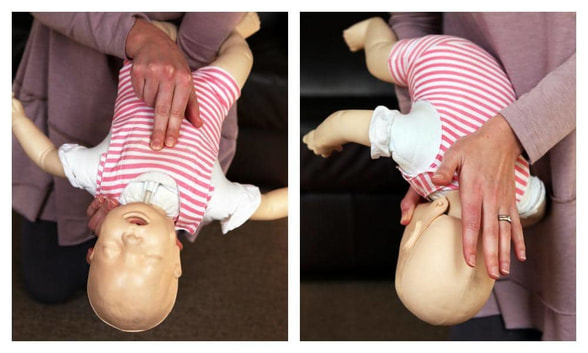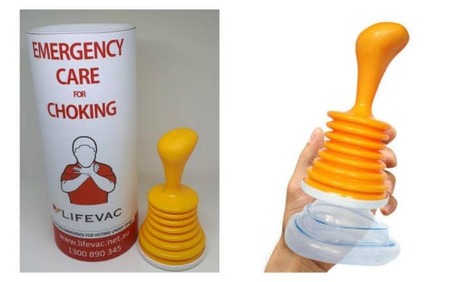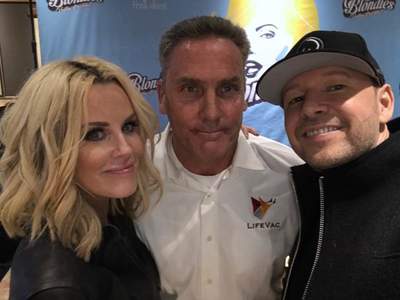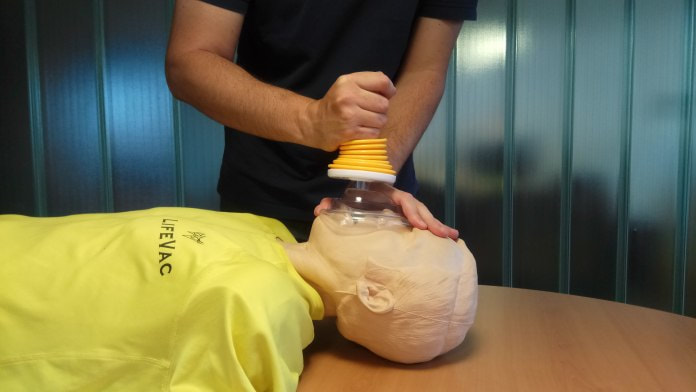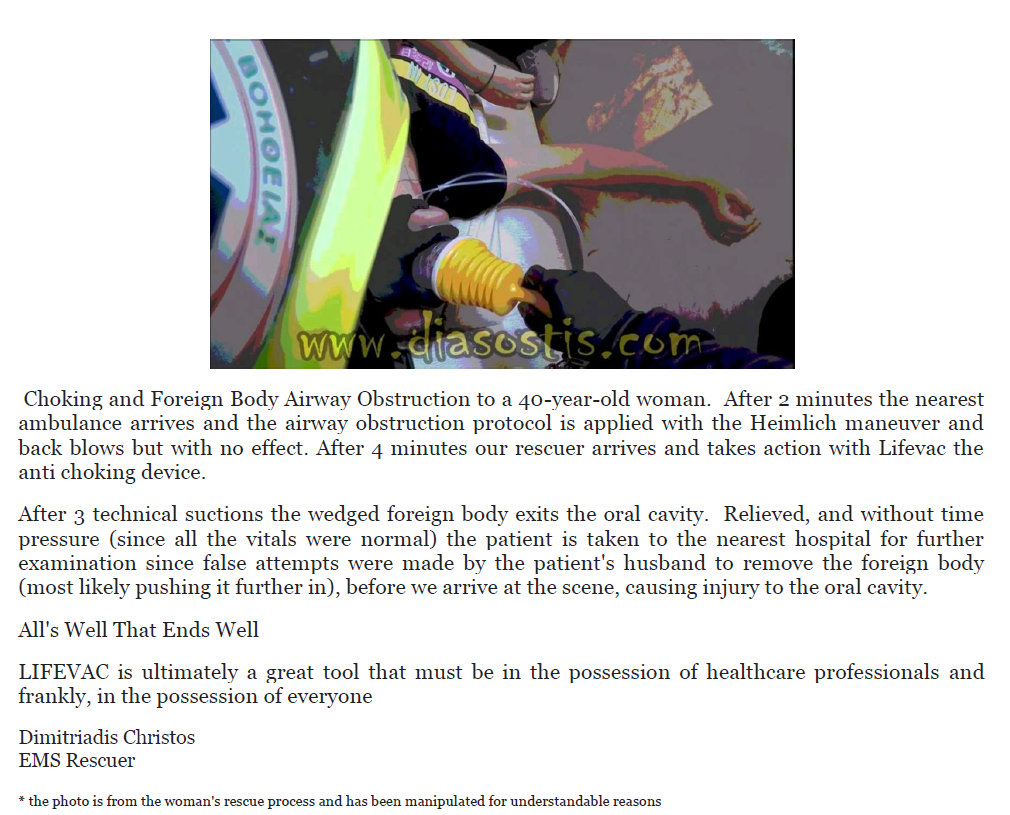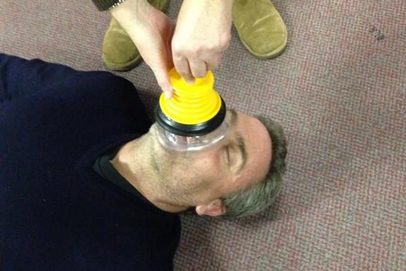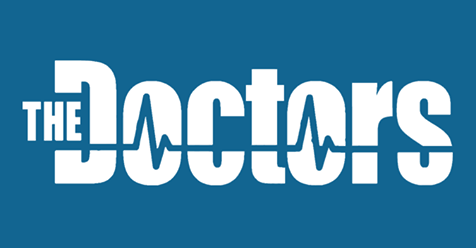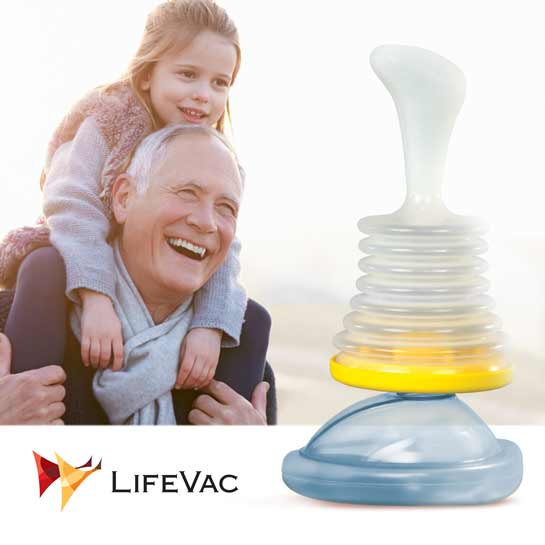LifeVac saves her 1 1/2 old from choking on a sunscreen seal. First aid had failed and paramedics were still on the way. LifeVac once again saves a life with no harm. In Australia go to www.lifevac.net.au.
Police Officers equipped with LifeVac
|
Police Bodycam captures Officers
|
In Western Australia there are some police vehicles equipped with LifeVac, but other states are yet to follow |
Police Officer equipped with a LifeVac
|
There are just a handful of time-critical emergencies that cannot wait for Paramedics to arrive.
Of these, severe choking is one of the most frightening.
The Bankstown Polish Club has now acquired a LifeVac medical device, a revolutionary device that could save lives in emergency situations where a person is choking on food or an object. The LifeVac is a vacuum-like device that is designed to create a negative pressure to remove obstructions in the airways of people who are choking. The greatest benefit of the LifeVac is that it can be used in situations where a traditional Heimlich manoeuvre would not work. For example, if someone is choking on a piece of food that is too large or has become lodged in the airway, the LifeVac can be used to safely and effectively remove the obstruction. This is especially important for individuals who may have a higher risk of choking, such as the elderly or individuals with disabilities. Another benefit of the LifeVac is its ease of use. It does not require any special training or certification, and the device comes with clear instructions on how to use it. This means that anyone can use the LifeVac in an emergency, even if they have no medical training. The Polish Club’s acquisition of the LifeVac medical device is a beneficial move that shows the club’s commitment to ensuring the safety of its members and patrons.
The LifeVac medical device is now available in the main auditorium, within easy reach of club members and patrons in case of an emergency. With this device on hand, the Polish Club can provide a safe environment for its members and guests, knowing that they have the necessary medical equipment to handle any emergency that may arise. This move is commendable and should be emulated by other clubs and organizations to ensure the safety of their members in all situations.
The LifeVac medical device is now available in the main auditorium, within easy reach of club members and patrons in case of an emergency. With this device on hand, the Polish Club can provide a safe environment for its members and guests, knowing that they have the necessary medical equipment to handle any emergency that may arise. This move is commendable and should be emulated by other clubs and organizations to ensure the safety of their members in all situations.
After the tragic death of 5 year old Imogen; the LifeVac could be the answer to choking
An interview with LifeVac inventor, Arthur Lih
|
Mother screams for help, LifeVac is the only one to answer the call
|
Fantastic news! LifeVac has saved its youngest choking person, a 3 week-old baby with no injuries reported. Although LifeVac is recommended for persons over 10 kg (approx. 12 months of age) this is a great result and is additional proof of the safety of the device. In fact, in all applications on the device on persons from 3 weeks to 95 years-of-age, there has never been any injury or harm caused by LifeVac and it has never failed to remove a choking obstruction. LifeVac, (unlike first aid), has a 100% success rate (first aid 50-70% even when trained).
This week a 5 yo choked on a popular lolly. His mothers' efforts using first aid measures failed to relieve the obstruction. Once again LIfeVac proves it self in saving another life.
Click on the picture to read the full story.
Click on the picture to read the full story.
|
|
Watch a mother tell the story of her son, saved by LifeVac after all first-aid measures failed when he choked on candy.
|
LifeVac on Fox News
11 MONTH OLD SAVED BY LIFEVAC
WHEN EVERYTHING ELSE HAD FAILED
WHEN EVERYTHING ELSE HAD FAILED
LifeVac saves another young life. Multiple attempts using first aid had failed and emergency operators underestimated the effectiveness of the LifeVac device to save a life. So far LifeVac has a 100% success rate (first aid <70%) in relieving an airway obstruction in choking in young children. In all cases the LifeVac has been found to be easy to use, safe and immediately effective. There are those who still doubt the LifeVac, however here just the latest testimonial of a very lucky little girl whose parents put their trust in LifeVac and are grateful that they did.
LifeVac saves it's 36th life
after first aid measures failed!
after first aid measures failed!
On the 27th of August LifeVac was informed once again of saving another child’s life!
Sue Stokes who is certified in the BLS protocol had to put her life saving skills to the test on Friday morning to save her son Nicholas’s life.
Sue who has had to previously put her life saving skills to the test 3 times previously, didn’t expect to have to do this again when her son Nicholas started to choke on peanut butter and bread.
Nicholas was eating his snack when he began to choke, Sue quickly realised her son was in trouble and unable to breath, she carried out the abdominal thrusts which she had done successfully before, but this time they did not work. Sue quickly remembered LifeVac that she had purchased years prior. She laid Nicholas on his side and quickly applied the LifeVac. With one application a large piece of peanut butter and bread roughly 3 inches long was dislodged saving Nicholas’s life.
Sue Stokes who is certified in the BLS protocol had to put her life saving skills to the test on Friday morning to save her son Nicholas’s life.
Sue who has had to previously put her life saving skills to the test 3 times previously, didn’t expect to have to do this again when her son Nicholas started to choke on peanut butter and bread.
Nicholas was eating his snack when he began to choke, Sue quickly realised her son was in trouble and unable to breath, she carried out the abdominal thrusts which she had done successfully before, but this time they did not work. Sue quickly remembered LifeVac that she had purchased years prior. She laid Nicholas on his side and quickly applied the LifeVac. With one application a large piece of peanut butter and bread roughly 3 inches long was dislodged saving Nicholas’s life.
Matthew Banagan from LifeVac Europe commented “Hearing of another life saved is amazing! This is LifeVac’s 6th child saved, knowing another child has their full life ahead of them thanks to his quick thinking mother and LifeVac is an amazing feeling. All of our lives saved have been when the first aid protocol has failed or has not been able to be performed, knowing we have created something that continues to save lives when all else fails is irreplaceable”.
Public Statement from LifeVac
It has been bought to our attention some recent articles/statements on social media/internet instigated by bloggers and social media trolls concerning LifeVac. These were made without contacting LifeVac directly to start a dialog or even ask for a sample of LifeVac to carry out independent testing or evaluation. Some resuscitation councils, healthcare professionals and journalists (without any further investigation of the validity of these claims) have taken notice of these slanderous bloggers and trolls (who have no medical background), and have released their own pre-emptive statements on suction devices. These articles do not reflect the evidence behind LifeVac or the LifeVac company. The medical evidence supporting LifeVac is available to anyone who has access to the internet and we will include the links in this statement.
When LifeVac first started out 5 years ago with our concept we contacted medical professionals and some resuscitation councils for guidance on the best route to take to show how effective noninvasive suction could be if implemented into BLS protocol. After researching statistics on choking, reviewing peer reviewed publications on the effectiveness of the abdominal thrusts (Heimlich Manoeuvre ), back blows and the many news articles where people have died when BLS procedures had failed; we discovered that existing choking protocols are only effective in 70% of cases when performed by a healthcare professional in a perfect situation.
LifeVac does not have the support from certain resuscitation councils; those who have not seen a LifeVac device. Only one has carried out their own evaluation (and decided to use and recommended the device). The reality is that resuscitation councils do not approve or recommend medical devices. This a function carried out in each country by Government, medical device, regulatory organisations. Luckily for LifeVac we have had doctors and medical professionals who take an interest in what we are trying to achieve and carried out their own evaluations.
One of the main questions/statements that seems to arise is that there are “no clinical trials behind these devices”. When asked “what trials would you like to see" (as testing on live
humans is unethical), no one seems to have the answer, even the people who are asking this question beyond what has already been done on a cadaver, anatomical models and the analysis of case reports, literature reviews and engineering testing. LifeVac is the only non-invasive suction device and only suction device with independent medical testing, peer reviewed publications and abstracts proving safety and effectiveness. Suction has been around for many years in ALS and ILS protocols to clear a foreign body airway obstruction. All LifeVac has done is made a non-invasive suction device that can be used by lay people when BLS has failed or where other method are impossible e.g. wheelchair bound patients. LifeVac has saved 31 lives around the world from choking to death when BLS has failed, these lives have been saved by Emergency Services, Nurses, Support workers and lay people. All lives saved have been documented and have been verified by authorities.
LifeVac has been implemented into Emergency Services/Paramedics, Police Departments, Fire Departments, Care Homes, Medical Practices, Child Care Services, Hospitals, Restaurants, Schools, Disability Services and many ordinary homes around the world.
LifeVac is not a novelty or a gimmick or a scam, the LifeVac medical device is safe to use and effective. We will not stop saving lives and will not give up pursuing our goal of getting non-invasive suction implemented into BLS choking protocol to raise the current 70% effectiveness to as close to a 100% effective as possible.
LifeVac is FDA registered, MHRA registered as a Class 1 Medical Device and CE accredited as well as listed on the ARTG.
LifeVac are always open for further independent testing or constructive suggestions, if you would like to suggest anything or have constructive guidance please feel free to contact us.
We urge readers to investigate the LifeVac for themselves, to read the evidence and make up their own minds, rather than fall in to the trap of believing those who have not seen, evaluated or tested the device; but merely seek to discredit the device and the company for other less honorable reasons.
Regardless of whether the "opinion or review" is from a suitably qualified person or not there are a few "red flags" the reader should watch out for to ensure that they are actually reading a honest and authentic evaluation, over an opinion without substance, these include when the writer:
LifeVac Medical Evidence:
Science Direct – Pressure Generated by LifeVac vs current methods
Published independent cadaver study – AJEM
International Journal Of Clinical Skills – 10 lives saved
LifeVac Adolescent Study – Annals of Emergency Medicine
American Journal Of Gastroenterology – LifeVac
For outbound pressure that proves no air can be forced through LifeVac’s interchangeable sized masks please contact us directly for this file.
Effectiveness of current BLS:
David Montoya Report – Management of the Choking Victim
Langhelle 2000 chest compression’s vs Heimlich Maneuver
Thorax – BMJ
Note: there is limited research on the abdominal thrusts and even less on back blows,
When LifeVac first started out 5 years ago with our concept we contacted medical professionals and some resuscitation councils for guidance on the best route to take to show how effective noninvasive suction could be if implemented into BLS protocol. After researching statistics on choking, reviewing peer reviewed publications on the effectiveness of the abdominal thrusts (Heimlich Manoeuvre ), back blows and the many news articles where people have died when BLS procedures had failed; we discovered that existing choking protocols are only effective in 70% of cases when performed by a healthcare professional in a perfect situation.
LifeVac does not have the support from certain resuscitation councils; those who have not seen a LifeVac device. Only one has carried out their own evaluation (and decided to use and recommended the device). The reality is that resuscitation councils do not approve or recommend medical devices. This a function carried out in each country by Government, medical device, regulatory organisations. Luckily for LifeVac we have had doctors and medical professionals who take an interest in what we are trying to achieve and carried out their own evaluations.
One of the main questions/statements that seems to arise is that there are “no clinical trials behind these devices”. When asked “what trials would you like to see" (as testing on live
humans is unethical), no one seems to have the answer, even the people who are asking this question beyond what has already been done on a cadaver, anatomical models and the analysis of case reports, literature reviews and engineering testing. LifeVac is the only non-invasive suction device and only suction device with independent medical testing, peer reviewed publications and abstracts proving safety and effectiveness. Suction has been around for many years in ALS and ILS protocols to clear a foreign body airway obstruction. All LifeVac has done is made a non-invasive suction device that can be used by lay people when BLS has failed or where other method are impossible e.g. wheelchair bound patients. LifeVac has saved 31 lives around the world from choking to death when BLS has failed, these lives have been saved by Emergency Services, Nurses, Support workers and lay people. All lives saved have been documented and have been verified by authorities.
LifeVac has been implemented into Emergency Services/Paramedics, Police Departments, Fire Departments, Care Homes, Medical Practices, Child Care Services, Hospitals, Restaurants, Schools, Disability Services and many ordinary homes around the world.
LifeVac is not a novelty or a gimmick or a scam, the LifeVac medical device is safe to use and effective. We will not stop saving lives and will not give up pursuing our goal of getting non-invasive suction implemented into BLS choking protocol to raise the current 70% effectiveness to as close to a 100% effective as possible.
LifeVac is FDA registered, MHRA registered as a Class 1 Medical Device and CE accredited as well as listed on the ARTG.
LifeVac are always open for further independent testing or constructive suggestions, if you would like to suggest anything or have constructive guidance please feel free to contact us.
We urge readers to investigate the LifeVac for themselves, to read the evidence and make up their own minds, rather than fall in to the trap of believing those who have not seen, evaluated or tested the device; but merely seek to discredit the device and the company for other less honorable reasons.
Regardless of whether the "opinion or review" is from a suitably qualified person or not there are a few "red flags" the reader should watch out for to ensure that they are actually reading a honest and authentic evaluation, over an opinion without substance, these include when the writer:
- Uses terms like "no evidence". Statements such as these are not scientific and show a biased opinion without scientific rigour. In the case of the LifeVac this is simply not true, especially in relation to saves. In addition, statements like "dangerous" are never supported by any evidence nor are do they quote any risks already associated with upper airway obstruction and current first aid measures.
- Uses the opinions of unqualified individuals as fact or evidence. e.g. a fashion importer rather than a scientist.
- Makes assumptions that are not factual: e.g. that resuscitation councils must endorse and recommend a medical device to make it legitimate.
- Assumes things about the subject of the review (the device) that show a lack of understanding i.e. actual physical assessment of the device e.g. "difficult to use", "ineffective", 'dangerous", etc. This includes statements that are just deliberately misleading e.g. the LifeVac claims to replace first aid measures. This is simply untrue. LifeVac is designed to be used after first aid measures fail...and they do fail! Following on from this is the flawed logic and science where the "reviewer" then makes assumptions about the rigour of the first aid measures currently used e.g. that CPR as a final measure has any relevant evidence for the relief of choking, when in fact the only limited evidence is success in deceased persons.
- Uses poor science in holding a device, such as LifeVac to a higher threshold of evidence than other devices or first aid measures. This assumes there is (or their needs to be "strong "evidence for any device or measure. If this were the case no first aid measures currently used would be "recommended" by any organisation. This poor science includes a failure acknowledge the validity of the research, testing and documented cases using the LifeVac but then failing to be able to suggest any research design that would satisfy their own threshold for evidence (above what has already been done, that in some cases exceeds some current first aid measures).
LifeVac Medical Evidence:
Science Direct – Pressure Generated by LifeVac vs current methods
Published independent cadaver study – AJEM
International Journal Of Clinical Skills – 10 lives saved
LifeVac Adolescent Study – Annals of Emergency Medicine
American Journal Of Gastroenterology – LifeVac
For outbound pressure that proves no air can be forced through LifeVac’s interchangeable sized masks please contact us directly for this file.
Effectiveness of current BLS:
David Montoya Report – Management of the Choking Victim
Langhelle 2000 chest compression’s vs Heimlich Maneuver
Thorax – BMJ
Note: there is limited research on the abdominal thrusts and even less on back blows,
DR MOMMY reviews the LifeVac and recommends it for your family.
Spendry reviews the LifeVac for your family.
HORROR IN THE CLASSROOM Toddler paralysed for life after choking on slice of apple at nursery
A TODDLER who choked on a piece of apple at his nursery has been left unable to walk, talk or swallow normally. Neihana Renata was just 22 months old when the shocking incident occurred at Little Lights Kindy in Rotorua, on New Zealand's North Island.
He was in cardiac arrest for 30 minutes, starving his brain of oxygen and leaving him with severe cerebral palsy. The peeled and sliced apple was prepared in the daycare centre 's kitchen and fed to all the children in the class. However, as the kids ate the snack, one of the teachers noticed little Neihana had worryingly started to choke. As she went to the aid of the stricken youngster, another teacher tried to remove the fruit lodged in his throat, reports Stuff.nz
One teacher tried mouth-to-mouth resuscitation but Neihana ended up vomiting blood into her mouth. He then fell unconscious and his skin began to change colour so nursery staff decided to call an ambulance. The toddler was taken to hospital and stayed in intensive care for two weeks, with a further two months on a regular ward. He now suffers from cerebral palsy and brain damage caused by the oxygen supply being cut off to his brain during the incident in May, 2016.
Doctors said Neihana was previously a healthy and "active" boy, and his development was "normal for his age", according to a new report written Dr Sarah Alexander from the ChildForum Early Childhood Education National Network. She has now called on New Zealand's Ministry of Education to tighten rules around food safety and first aid training. Dr Alexander wrote: “As typical of children his age, he did not have a full set of teeth having neither first nor second molars (essential for grinding food). “Children’s second molars do not normally come through completely until they are over 2.6 years old. His mum described him as being very smiley and loving.
He was in cardiac arrest for 30 minutes, starving his brain of oxygen and leaving him with severe cerebral palsy. The peeled and sliced apple was prepared in the daycare centre 's kitchen and fed to all the children in the class. However, as the kids ate the snack, one of the teachers noticed little Neihana had worryingly started to choke. As she went to the aid of the stricken youngster, another teacher tried to remove the fruit lodged in his throat, reports Stuff.nz
One teacher tried mouth-to-mouth resuscitation but Neihana ended up vomiting blood into her mouth. He then fell unconscious and his skin began to change colour so nursery staff decided to call an ambulance. The toddler was taken to hospital and stayed in intensive care for two weeks, with a further two months on a regular ward. He now suffers from cerebral palsy and brain damage caused by the oxygen supply being cut off to his brain during the incident in May, 2016.
Doctors said Neihana was previously a healthy and "active" boy, and his development was "normal for his age", according to a new report written Dr Sarah Alexander from the ChildForum Early Childhood Education National Network. She has now called on New Zealand's Ministry of Education to tighten rules around food safety and first aid training. Dr Alexander wrote: “As typical of children his age, he did not have a full set of teeth having neither first nor second molars (essential for grinding food). “Children’s second molars do not normally come through completely until they are over 2.6 years old. His mum described him as being very smiley and loving.
All schools in Northern Ireland to be equipped with LifeVac...
By Victoria Leonard
September 17 2018
An organisation set up in memory of a woman who choked to death is aiming to fund lifesaving equipment for every school in Northern Ireland, just over a year after her death. Sherry Campbell, an only child from Groomsport in Co Down, was found dead in the kitchen of her family home by her father Shannon in the early hours of September 7, 2017. The 29-year-old, a special needs teaching assistant at Strangford College in Carrowdore, choked to death on a piece of meat.
She had died alone and had been unable to call out to her parents who were asleep upstairs and had their mobile phones on silent mode.
Following her death, her family set up The Sherry Campbell Foundation to raise awareness of the dangers of choking. As part of its work, Sherry's friend Danielle Elmes (39) designed the LifeAlert app, which alerts friends and family that victims are in danger and uses their mobile phone's GPS to identify their location at the touch of a button. Now, using the proceeds gained from the app and from funds donated to the foundation by supporters, it is planning to purchase around 1,200 LifeVacs - enough for every primary and secondary school here. The non-powered portable suction device is designed to resuscitate a choking victim after standard protocol has been followed without success.
Mum-of-three Danielle says Sherry was "like a little sister" to her.
"Last Friday was the anniversary and it was a really strange, difficult day," she told the Belfast Telegraph.
"I can't believe it has been a year since Sherry's death.
"In that time the foundation has run some first aid classes, launched the app, and now we almost have enough money for LifeVacs, which the foundation is hoping to provide to every school.
"If someone has something lodged in their airway and other manoeuvres have not got it out, this device is placed over the mouth, creating a seal which pulls the object back out.
"It has already saved about 12 lives across the world where a standard procedure has failed.
"We are in discussions with the inventor, who has been part of the campaign since a few weeks after Sherry died, over the purchases.
"And after the LifeVacs are installed in schools we will show people how to use them.
"We have also had about 300 downloads of the app and I am now training to be able to provide first aid classes."
The work of the charity has already saved lives...
"Since we launched the foundation's website we have been contacted by a woman who said her son had saved her from choking to death after seeing the information on the page," Danielle explained.
"I hope that having these LifeVacs in schools could save other lives, and will provide reassurance to parents.
"Something positive has come out of this tragedy.
I do think that Sherry has been watching down on us doing all this work. "I think she would be happy that people still remember her, and that she is remembered so fondly."
Sherry's grieving mum Fionuala described the first anniversary of her daughter's death as tough.
"I don't want any other parents to have to go through what we have went through," Fionuala added. "Sherry's anniversary was totally raw, and reliving the horrendous moments I felt numb with grief. "Thanks to the work of the foundation, everyone has become so aware of the dangers of choking. "And having these LifeVacs in schools here will make a big difference. "This is Sherry's legacy."
Belfast Telegraph
September 17 2018
An organisation set up in memory of a woman who choked to death is aiming to fund lifesaving equipment for every school in Northern Ireland, just over a year after her death. Sherry Campbell, an only child from Groomsport in Co Down, was found dead in the kitchen of her family home by her father Shannon in the early hours of September 7, 2017. The 29-year-old, a special needs teaching assistant at Strangford College in Carrowdore, choked to death on a piece of meat.
She had died alone and had been unable to call out to her parents who were asleep upstairs and had their mobile phones on silent mode.
Following her death, her family set up The Sherry Campbell Foundation to raise awareness of the dangers of choking. As part of its work, Sherry's friend Danielle Elmes (39) designed the LifeAlert app, which alerts friends and family that victims are in danger and uses their mobile phone's GPS to identify their location at the touch of a button. Now, using the proceeds gained from the app and from funds donated to the foundation by supporters, it is planning to purchase around 1,200 LifeVacs - enough for every primary and secondary school here. The non-powered portable suction device is designed to resuscitate a choking victim after standard protocol has been followed without success.
Mum-of-three Danielle says Sherry was "like a little sister" to her.
"Last Friday was the anniversary and it was a really strange, difficult day," she told the Belfast Telegraph.
"I can't believe it has been a year since Sherry's death.
"In that time the foundation has run some first aid classes, launched the app, and now we almost have enough money for LifeVacs, which the foundation is hoping to provide to every school.
"If someone has something lodged in their airway and other manoeuvres have not got it out, this device is placed over the mouth, creating a seal which pulls the object back out.
"It has already saved about 12 lives across the world where a standard procedure has failed.
"We are in discussions with the inventor, who has been part of the campaign since a few weeks after Sherry died, over the purchases.
"And after the LifeVacs are installed in schools we will show people how to use them.
"We have also had about 300 downloads of the app and I am now training to be able to provide first aid classes."
The work of the charity has already saved lives...
"Since we launched the foundation's website we have been contacted by a woman who said her son had saved her from choking to death after seeing the information on the page," Danielle explained.
"I hope that having these LifeVacs in schools could save other lives, and will provide reassurance to parents.
"Something positive has come out of this tragedy.
I do think that Sherry has been watching down on us doing all this work. "I think she would be happy that people still remember her, and that she is remembered so fondly."
Sherry's grieving mum Fionuala described the first anniversary of her daughter's death as tough.
"I don't want any other parents to have to go through what we have went through," Fionuala added. "Sherry's anniversary was totally raw, and reliving the horrendous moments I felt numb with grief. "Thanks to the work of the foundation, everyone has become so aware of the dangers of choking. "And having these LifeVacs in schools here will make a big difference. "This is Sherry's legacy."
Belfast Telegraph
Kidspot reviews LifeVac for parents...
The anti-choking device that parents are now turning to
Dr Sam Hay | March 20, 2018
Is the popular first aid device safe? Dr Sam Hay weighs in. Being a parent is tough - the sleepless nights and just the beginning. Then there’s the fear of losing our precious ones to some sort of accident. It triggers a constant angst – how do we protect but still allow ? We feel like we never get it right.
Choking is just one of the ways our kids can come into harms way. Good development demands inquisitive little kids to explore the world around them. They must test everything they touch and see, and that inevitably leads to little bits and pieces ending up exactly where they shouldn’t be – the mouth.
In fact, in kids under twelve months, and second for all children under 14 years. Food such as lollies, meat and nuts are associated half the time. With the other half, objects such as coins and toy parts are to blame.
Dr Sam Hay | March 20, 2018
Is the popular first aid device safe? Dr Sam Hay weighs in. Being a parent is tough - the sleepless nights and just the beginning. Then there’s the fear of losing our precious ones to some sort of accident. It triggers a constant angst – how do we protect but still allow ? We feel like we never get it right.
Choking is just one of the ways our kids can come into harms way. Good development demands inquisitive little kids to explore the world around them. They must test everything they touch and see, and that inevitably leads to little bits and pieces ending up exactly where they shouldn’t be – the mouth.
In fact, in kids under twelve months, and second for all children under 14 years. Food such as lollies, meat and nuts are associated half the time. With the other half, objects such as coins and toy parts are to blame.
Parents and carers are encouraged to cut grapes before serving to young children. Image: iStock
What does someone who’s choking look like? Difficulty breathing and obvious distress will be the biggest clues. As oxygen is depleted, their body they will gradually turn blue, first noticed around the mouth and face. As times go on, unconsciousness and death could occur in minutes.
When it comes to choking, we need to work fast
Time is of the essence with choking, so needs to be delivered quickly and effectively.
I urge every parent to complete an accredited first aid course, and work hard to keep it up to date as the years go on. But first aid for choking only goes so far.
When it comes to choking, we need to work fast
Time is of the essence with choking, so needs to be delivered quickly and effectively.
I urge every parent to complete an accredited first aid course, and work hard to keep it up to date as the years go on. But first aid for choking only goes so far.
Dr Sam urges us all to learn basic first aid. Image: iStock
COMMON CHOKING HAZARDS IN YOUR HOME
Along with the basics of checking the ABC’s, choking first aid has traditionally relied on a couple of crude techniques. These techniques create a pulse of air akin to a cough, and are performed with the aim of dislodging any offending blockage and sending it flying.
You’d first start with some sharp blows to the back; then failing that, it’s the old ‘Heimlich Maneuver’ – a series of abdominal thrusts – but only useful for the conscious, and far too dangerous for babies.
Sadly, history tells us that these techniques are far too unreliable.
And that’s where the comes in - a hand held device that works like a fancy drain plunger. It’s marketed as being so easy to use you could do it on yourself!
Along with the basics of checking the ABC’s, choking first aid has traditionally relied on a couple of crude techniques. These techniques create a pulse of air akin to a cough, and are performed with the aim of dislodging any offending blockage and sending it flying.
You’d first start with some sharp blows to the back; then failing that, it’s the old ‘Heimlich Maneuver’ – a series of abdominal thrusts – but only useful for the conscious, and far too dangerous for babies.
Sadly, history tells us that these techniques are far too unreliable.
And that’s where the comes in - a hand held device that works like a fancy drain plunger. It’s marketed as being so easy to use you could do it on yourself!
LifeVac has saved 11 lives so far. Image: LifeVac Australia
What exactly is this LifeVac device? And does it work?
A flexible plunger device is attached to a face guard. The face guard is sealed around the nose and mouth, with the plunger sharply elevated, thereby creating an effective suction through the airways, designed to quickly dislodge blockages. In fact, the device is capable of producing a degree of suction that far exceeds those achievable by any first aid technique.
It makes sense. Plus, the good news is, it works.
Numerous studies have reported success in simulated environments, showing the device removing blockages of many sizes within one, two, or three attempts. They even tested it with hotdogs – one of the most common choking hazards.
Look, it’s not foolproof, and it’s not without some (small) potential for injury in toddlers and babies. But faced with the devastating alternatives, I’d encourage parents to consider having one handy, and definitely giving it a go after first aid techniques have failed and the ambulance is on its way.
A flexible plunger device is attached to a face guard. The face guard is sealed around the nose and mouth, with the plunger sharply elevated, thereby creating an effective suction through the airways, designed to quickly dislodge blockages. In fact, the device is capable of producing a degree of suction that far exceeds those achievable by any first aid technique.
It makes sense. Plus, the good news is, it works.
Numerous studies have reported success in simulated environments, showing the device removing blockages of many sizes within one, two, or three attempts. They even tested it with hotdogs – one of the most common choking hazards.
Look, it’s not foolproof, and it’s not without some (small) potential for injury in toddlers and babies. But faced with the devastating alternatives, I’d encourage parents to consider having one handy, and definitely giving it a go after first aid techniques have failed and the ambulance is on its way.
Hollywood actor Jenny McCarthy is starstruck when she meets the inventor
of the LifeVac, Arthur Lih.
of the LifeVac, Arthur Lih.
Arthur remarked after the encounter that Jenny and her husband Donnie Wahlberg (American Singer Songwriter) as "two of the kindest , warm , considerate people. They are LifeVac kind of people , plus they said they would share about the ones they bought when they get home , they thanked me for what I do. Wonderful people."
PEGO INSTALLS LIFEVAC DEVICES TO PREVENT DEATHS FROM CHOKING
The municipality of Pego, pioneer in the prevention of suffocation by choking in schools.
By
Drafting
February 8, 2018
The municipality of Pego has acquired 6 LifeVac devices against suffocation due to choking, becoming in this way a pioneer in the prevention of deaths caused by this type of accidents. The devices are destined to be placed in all the educational centres of the municipality distributing in 4 schools, a Secondary Education Institute and the municipal nursery school.
On the other hand, together with the devices, the consistory has also trained all the staff of the educational centres on how to act in case of accident by choking. The training of manoeuvres and protocols has been given in different days by the organization "Accio Urgent".
In this case, the students of the Institute of Secondary Education have had the opportunity to take part in the training and learn how to act in case of choking and how to use the LifeVac device.
Asphyxia by choking is one of the main causes of accidental death causing 1,900 deaths per year in Spain, a number of deaths very close to 2,100 caused by traffic accidents.
According to Pedro Barranco de Accio Urgent, "in case of choking brain death begins in only 4 minutes so it is vital to know how to act and do it quickly." Likewise, it is necessary that the emergency devices are located near the accident site to act immediately and increase the chances of success.
The consistory, aware of this type of accidents, thus improves the security of the town.
The municipality of Pego, pioneer in the prevention of suffocation by choking in schools.
By
Drafting
February 8, 2018
The municipality of Pego has acquired 6 LifeVac devices against suffocation due to choking, becoming in this way a pioneer in the prevention of deaths caused by this type of accidents. The devices are destined to be placed in all the educational centres of the municipality distributing in 4 schools, a Secondary Education Institute and the municipal nursery school.
On the other hand, together with the devices, the consistory has also trained all the staff of the educational centres on how to act in case of accident by choking. The training of manoeuvres and protocols has been given in different days by the organization "Accio Urgent".
In this case, the students of the Institute of Secondary Education have had the opportunity to take part in the training and learn how to act in case of choking and how to use the LifeVac device.
Asphyxia by choking is one of the main causes of accidental death causing 1,900 deaths per year in Spain, a number of deaths very close to 2,100 caused by traffic accidents.
According to Pedro Barranco de Accio Urgent, "in case of choking brain death begins in only 4 minutes so it is vital to know how to act and do it quickly." Likewise, it is necessary that the emergency devices are located near the accident site to act immediately and increase the chances of success.
The consistory, aware of this type of accidents, thus improves the security of the town.
LifeVac saves its 8th life.
"My daughter was choking on a sandwich. Being trained in CPR, I tried to relieve it; however it was not working. I then called the ambulance. I threw her on the floor and used the LIFEVAC. By the time the police arrived at my home, Heather was no longer CHOKING. It was because I used LIFEVAC! |
"Last week we had a guest over for dinner, and she started choking on a piece of meat. My husband started trying first aid on her, but while the food was lodged, it didn't completely close off her airway, so the first aid wasn't working. Luckily he remembered we had the LifeVac, so I ran and got it. One pull on the LifeVac and the food came right out. I am so so grateful we had it in our home, ready to use. When I first learned about the LifeVac tool, I knew we needed to have it in our home. Thankfully we had it when we needed it last week. It would have taken an ambulance over 10 minutes to get here. It was very scary. The LifeVac is worth every penny. Please take a moment and look into it. Get one if you can. It works. It saved a life in our home, for which I am very very grateful."
- Angela Ferris Powell
"I wanted to write a testimonial so that the team at LifeVac can share my story with others. I first heard of LifeVac via Facebook and thought this was an great product that I must have in my home for my daughter. My daughter, Heather who is 31 years old has a swallowing disorder (dysphagia) since a very young age. I ordered LifeVac back in November of 2014 and since then it has always been easily accessible my home. Back in October of 2016 when we went to the Mayo Clinic I even had it with me. I showed the physicians as I believe it is an amazing device. The doctors thought it was brilliant. On September 7, 2015 I prepared lunch for Heather. I made a mashed up tuna sandwich with mayonnaise. I even added extra mayo so it would make it easier for her swallow. While eating I noticed she was choking. I am trained in CPR and immediately started to perform the Heimlich manoeuvre, however, it was not working. I then called 911. I knew at the point to grab the LifeVac. I laid Heather on the floor and placed the LifeVac over her nose & mouth. When the police arrived at my home, Heather was no longer choking. Thankfully I had a LifeVac. The device was easy to use and I know it saved my daughter! Anywhere I go with her, I always have LifeVac with me. I tell everyone I know about this amazing product." - Claire Duvall
|
|
LifeVac Registers First Successful Rescue of Choking VictimFARMINGDALE, N.Y., June 6, 2016 /PRNewswire/ -- LifeVac, the device designed to save the life of a choking victim, has saved the life of a female nursing home resident in Dyfed, Wales.
|
EMS WIRE article on LifeVacWhat happens when your little boy chokes on a piece of chicken and the back blows and abdominal thrusts just aren’t working? Other than continuing to pounding on their chest like an ape, reaching down their throat with grandma’s back-scratcher, or cutting a hole in their windpipe, there really isn’t much you can do. This is the same fear that motivated Arthur Lih to create LifeVac-- a simple, effective anti-choking device for when all else fails.
|
Assessment of the LifeVac, an anti-choking device, on a human cadaver with complete airway obstruction Juliano Mimi, Domingo Robert, Mooney Mary S., Trupiano Alex, Assessment of the LifeVac, an anti-choking device, on a human cadaver with complete airway obstruction, American Journal of Emergency Medicine (2016), doi: 10.1016/j.ajem.2016.03.047
We performed an independent study to determine whether the anti-choking device, LifeVac, is capable of removing a food bolus from an obstructed airway when the potential for choking as a medical emergency exists |
|
Toddler dies in Perth shopping centre after choking and failure of first aid measures to relieve the obstruction
Two-year-old Essa Rahman died in a WA shopping centre after the multiple (4) attempts to relieve the upper airway obstruction. LifeVac has been designed and proven to help where first aid attempts have failed. |
LifeVac Review - Can New Devices Match Heimlich to Stop Choking?
The efficacy and usability of suction-based airway clearance devices for foreign body airway obstruction: a manikin randomised crossover trial
A new study has directly compared LifeVac with both Abdominal Thrusts (the primary first-aid measure for choking recommended by ILCOR) and the Dechoker device. The study found that for the primary outcome, the FBAO was successfully removed in 99% cases with LifeVac, 74% cases with Dechoker, and 71% cases with abdominal thrusts . The odds of successful removal was significantly higher in the LifeVac group than abdominal thrusts but was not significantly higher in the Dechoker group compared with abdominal thrusts.
Mum saves her 2 year-old with LifeVac and it is all captured on CCTV
A mum in Florida saves her 2-year-old son from a choking incident with LifeVac! Parents, please watch and share this home security video. No script, no creative editing, just life as it happened. First aid measures are not always effective but luckily this young mum had decided to buy a LifeVac airway clearance device and to keep it handy to protect her two precious children. This day, it paid off. Now her child is thankfully one of the over 60 children already saved the LifeVac device.
Arthur Lih: Saving Millions of Lives around the Globe
The 10 Most Revolutionary Business Leaders to Watch in 2022 - CIO News October 2022
Founded by Arthur Lih, LifeVac aims to practically eradicate the fourth leading cause of accidental death and save the life of a choking victim. He is the CEO and founder of LifeVac USA. LifeVac is an FDA registered class II airway clearing device that will clear obstructions from a choking victim’s airway.
About 10 years ago, Arthur visited a friend in the hospital, which has turned into a decade-long mission to change the world. His friend’s mother was having a procedure, so Arthur stopped by to keep him company. While they waited, his friend pointed across the room to a chilly, steel gurney and remarked, “The last time I was here, a 7-year-old child died on that gurney.” “He remembered the commotion of personnel feverishly attempting to save this youngster, but nothing could remove the grape.” He recalled the parents’ agony and unrestrained crying, the staff’s tears, and the anguish that filled the room.”
Arthur’s daughter was seven years old at the time this tale was given to him, and he could fathom the anguish of losing someone you care about, especially a child. Arthur could picture his daughter on the stretcher in his mind, and he knew he couldn’t allow anything to happen to her. That night, he began his investigation to determine whether there was anything that could be utilized to save a choking victim if the Heimlich maneuver failed.
LifeVac; A Life Saving Device
LifeVac is a single-patient, non-invasive, non-powered portable suction appliance designed to save the life of a choking victim. The device works by creating a vacuum in the choking patient’s oral cavity. The suction generated by the device allows users to remove obstructions in the patient’s airway without the residual trauma sometimes incurred through the use of abdominal thrusts. According to the official website, the device is patented, FDA registered, and manufactured in the United States – and it can be used by anybody, guaranteeing that even the most critical circumstances are addressed.
The device resembles a plunger in appearance, and the idea is identical. The plunger is connected to a simple non-rebreather mask which is placed over the patient’s mouth to create an airtight seal. Once the user has a firm seal around the patient’s mouth, the user presses down on the handle. This motion pushes all of the air out of the device. The device utilizes a patented one-way valve which not only prevents the obstruction from being pushed further into the lungs but simultaneously creates a vacuum in the patient’s pharynx and oral cavity. When the user pulls back on the handle, pressure is generated by the vacuum. The effect creates an instantaneous moment of suction that dislodges the obstruction in the throat. The device has shown tremendous results so far. Everything from plastic bottle caps to pieces of bread have been removed from choking individuals.
LifeVac is a life-saving device that everyone should have on hand in case of an emergency. The device is simple to use and may be used on anyone, making it easier to open the airway in any scenario. Because the user may use LifeVac without assistance, no one needs to worry about being alone in an emergency. The device is simple to operate, and the one-way pressure swiftly removes a variety of objects in the airway’s route.
The LifeVac device is capable of reducing choking statistics. With one child dying every five days and over 5,000 choking deaths each year, LifeVac has the potential to eliminate choking-related tragedies. In the last 50 years, there have been no advancements in choking procedures. For the first time in history, a major cause of unintentional fatalities may be virtually eradicated.
Life before LifeVac
After graduating from Stony Brook University in New York, Arthur entered the air transportation sector, swiftly learning everything there is to know about trucking and air freight before launching his own logistics firm, ALBS Logistics. Over the following 18 years, he and his partner amassed an astounding yearly income of more than $20 million. He adds that his expertise in creating that company was critical and helped with the success of LifeVac when he first launched it.
Arthur produced the first LifeVac device in his garage many years ago using supplies he bought at a local hardware store. The prototype would go on to be modified into the current model on the market. His past experience in shipping aided in the logistics of transporting merchandise all over the world.
Stepping on a Path to Saving Lives
Arthur was 47 years old, had sold the firm he had created from the ground up, and was getting ready to retire. He couldn’t bear the notion of something happening to his daughter after hearing the story of a child who died after choking on a grape. When the Heimlich technique failed to save a choking youngster, he began his studies to discover whether there was anything else that could be done. There were a few different items, but they all featured a long, thin tube coupled with some kind of suction. He shares, “I felt that if I was in a panic, I would not trust myself to use one. I thought that there needed to be a safer, panic-proof way to save a choking victim if all other measures were unsuccessful.”
He knew he could save his daughter and asked himself, “How could I not help save other lives in a choking emergency?” He further adds that it was a decision he knew he had to make and in building a company, Arthur knew he could save so many lives with the rescue device.
In June of 2016, Arthur received news that the device had saved the first life. He mentions, “2022 has not ended and we have saved 370+ lives from choking deaths when the BLS protocol failed or could not be performed.” Our medical devices have changed so many families’ lives.”
Arthur shares that success to him means: “Being able to take care of my family, raising a well-rounded and proper daughter, being able to give back, and helping others.” And he will continue on his path to end accidental choking tragedies and save countless lives.
Success has No ‘Easy Path’
“Persevering to continue on a path when I was told time after time this could not be done,” says Arthur. It took Arthur around 4 years to get LifeVac from a prototype to a product that could be manufactured. During that period, dozens of independent third-party tests were completed, medical journals were published, and preparations were made to bring the LifeVac to market. LifeVac is currently available all over the world.
Arthur made something out of nothing. Creating and manufacturing a life-saving medical device was a massive undertaking. He and his team grew LifeVac into a global medical technology firm devoted to saving lives all around the world.
A small group of determined people can change the world. Considering himself a successful person while holding a child in his arms whose life was saved with the LifeVac device, Arthur shares, “Our LifeVac staff wants to stop senseless choking deaths.”
The Motivation to Save Lives
“When we receive a report from a family letting us know that they saved their loved one with LifeVac, we celebrate that life saved,” says Arthur. Every day, his team works hard to raise awareness about how LifeVac’s product may save a life in a choking situation. He says there is no higher satisfaction than knowing you contributed to someone’s life being saved.
Arthur’s goal is to save a million lives before his time here is up. He shares he will continue to give it all he has and says “Never give up! You can achieve your dreams.” His motto is “Sometimes you have to do the impossible just to prove that nothing is.”
About 10 years ago, Arthur visited a friend in the hospital, which has turned into a decade-long mission to change the world. His friend’s mother was having a procedure, so Arthur stopped by to keep him company. While they waited, his friend pointed across the room to a chilly, steel gurney and remarked, “The last time I was here, a 7-year-old child died on that gurney.” “He remembered the commotion of personnel feverishly attempting to save this youngster, but nothing could remove the grape.” He recalled the parents’ agony and unrestrained crying, the staff’s tears, and the anguish that filled the room.”
Arthur’s daughter was seven years old at the time this tale was given to him, and he could fathom the anguish of losing someone you care about, especially a child. Arthur could picture his daughter on the stretcher in his mind, and he knew he couldn’t allow anything to happen to her. That night, he began his investigation to determine whether there was anything that could be utilized to save a choking victim if the Heimlich maneuver failed.
LifeVac; A Life Saving Device
LifeVac is a single-patient, non-invasive, non-powered portable suction appliance designed to save the life of a choking victim. The device works by creating a vacuum in the choking patient’s oral cavity. The suction generated by the device allows users to remove obstructions in the patient’s airway without the residual trauma sometimes incurred through the use of abdominal thrusts. According to the official website, the device is patented, FDA registered, and manufactured in the United States – and it can be used by anybody, guaranteeing that even the most critical circumstances are addressed.
The device resembles a plunger in appearance, and the idea is identical. The plunger is connected to a simple non-rebreather mask which is placed over the patient’s mouth to create an airtight seal. Once the user has a firm seal around the patient’s mouth, the user presses down on the handle. This motion pushes all of the air out of the device. The device utilizes a patented one-way valve which not only prevents the obstruction from being pushed further into the lungs but simultaneously creates a vacuum in the patient’s pharynx and oral cavity. When the user pulls back on the handle, pressure is generated by the vacuum. The effect creates an instantaneous moment of suction that dislodges the obstruction in the throat. The device has shown tremendous results so far. Everything from plastic bottle caps to pieces of bread have been removed from choking individuals.
LifeVac is a life-saving device that everyone should have on hand in case of an emergency. The device is simple to use and may be used on anyone, making it easier to open the airway in any scenario. Because the user may use LifeVac without assistance, no one needs to worry about being alone in an emergency. The device is simple to operate, and the one-way pressure swiftly removes a variety of objects in the airway’s route.
The LifeVac device is capable of reducing choking statistics. With one child dying every five days and over 5,000 choking deaths each year, LifeVac has the potential to eliminate choking-related tragedies. In the last 50 years, there have been no advancements in choking procedures. For the first time in history, a major cause of unintentional fatalities may be virtually eradicated.
Life before LifeVac
After graduating from Stony Brook University in New York, Arthur entered the air transportation sector, swiftly learning everything there is to know about trucking and air freight before launching his own logistics firm, ALBS Logistics. Over the following 18 years, he and his partner amassed an astounding yearly income of more than $20 million. He adds that his expertise in creating that company was critical and helped with the success of LifeVac when he first launched it.
Arthur produced the first LifeVac device in his garage many years ago using supplies he bought at a local hardware store. The prototype would go on to be modified into the current model on the market. His past experience in shipping aided in the logistics of transporting merchandise all over the world.
Stepping on a Path to Saving Lives
Arthur was 47 years old, had sold the firm he had created from the ground up, and was getting ready to retire. He couldn’t bear the notion of something happening to his daughter after hearing the story of a child who died after choking on a grape. When the Heimlich technique failed to save a choking youngster, he began his studies to discover whether there was anything else that could be done. There were a few different items, but they all featured a long, thin tube coupled with some kind of suction. He shares, “I felt that if I was in a panic, I would not trust myself to use one. I thought that there needed to be a safer, panic-proof way to save a choking victim if all other measures were unsuccessful.”
He knew he could save his daughter and asked himself, “How could I not help save other lives in a choking emergency?” He further adds that it was a decision he knew he had to make and in building a company, Arthur knew he could save so many lives with the rescue device.
In June of 2016, Arthur received news that the device had saved the first life. He mentions, “2022 has not ended and we have saved 370+ lives from choking deaths when the BLS protocol failed or could not be performed.” Our medical devices have changed so many families’ lives.”
Arthur shares that success to him means: “Being able to take care of my family, raising a well-rounded and proper daughter, being able to give back, and helping others.” And he will continue on his path to end accidental choking tragedies and save countless lives.
Success has No ‘Easy Path’
“Persevering to continue on a path when I was told time after time this could not be done,” says Arthur. It took Arthur around 4 years to get LifeVac from a prototype to a product that could be manufactured. During that period, dozens of independent third-party tests were completed, medical journals were published, and preparations were made to bring the LifeVac to market. LifeVac is currently available all over the world.
Arthur made something out of nothing. Creating and manufacturing a life-saving medical device was a massive undertaking. He and his team grew LifeVac into a global medical technology firm devoted to saving lives all around the world.
A small group of determined people can change the world. Considering himself a successful person while holding a child in his arms whose life was saved with the LifeVac device, Arthur shares, “Our LifeVac staff wants to stop senseless choking deaths.”
The Motivation to Save Lives
“When we receive a report from a family letting us know that they saved their loved one with LifeVac, we celebrate that life saved,” says Arthur. Every day, his team works hard to raise awareness about how LifeVac’s product may save a life in a choking situation. He says there is no higher satisfaction than knowing you contributed to someone’s life being saved.
Arthur’s goal is to save a million lives before his time here is up. He shares he will continue to give it all he has and says “Never give up! You can achieve your dreams.” His motto is “Sometimes you have to do the impossible just to prove that nothing is.”

